Escalation in Gaza: Israel and Hamas Resume Intense Fighting

In the first hours after the collapse of a week-long truce, Israeli strikes on houses and buildings in the Gaza Strip resulted in at least 178 Palestinian deaths, as reported by the Gaza Health Ministry. Israel confirmed targeting over 200 Hamas sites. This fierce combat marks a significant escalation after a period of relative calm, underscoring the fragility of the region’s peace efforts.
The fighting intensified around a hospital in northern Gaza, raising Palestinian concerns about another painful standoff and potential evacuation. This hospital has been sheltering thousands of patients and displaced people for weeks, following similar clashes near another hospital in Gaza City.
Renewed bombardments by Israeli warplanes on Gaza came after the failure of talks to extend the truce with Hamas. This led to a surge of casualties, with many wounded and dead Palestinians admitted to hospitals and hundreds more fleeing in the streets.
U.S. Vice President Kamala Harris, commenting on the situation, stated that too many innocent Palestinians had been killed. She emphasized Israel’s right to defend itself while underscoring the importance of respecting international and humanitarian law. U.S. Defense Secretary Lloyd Austin echoed these sentiments, highlighting the moral responsibility to protect Gaza civilians. Israeli Prime Minister Benjamin Netanyahu affirmed Israel’s efforts to work with the U.S. and international organizations to establish “safe areas” for Gaza civilians, clarifying that while Israel aims to harm Hamas, it does not wish to harm the general population.
Harris also outlined a vision for a post-conflict Gaza, advocating for a unified Gaza and West Bank under the Palestinian Authority, with a central role for Palestinian voices and aspirations. This vision includes the removal of Hamas from power in Gaza. Since 2007, Hamas has controlled Gaza, after seizing it from the Palestinian President Mahmoud Abbas’ Fatah party.
The recent surge in violence has overwhelmed medical facilities in Gaza. The Nasser Hospital in Khan Younis reported a continuous influx of wounded individuals, with at least 650 people wounded since the truce’s end. The International Committee of the Red Cross described the renewed fighting as intense【20†source】.
Both Israel and Hamas blamed each other for the breakdown of the truce. During the ceasefire, Hamas had released hostages in exchange for Palestinian prisoners held in Israeli jails. Israel accused Hamas of failing to fulfill a deal to free all women and children it was holding, leading to the withdrawal of an Israeli negotiation team from Qatar.
In southern Gaza, including areas like Khan Younis and Rafah, Israeli bombardments caused significant damage to residential areas and religious sites. Meanwhile, Hamas launched rocket barrages targeting Tel Aviv, leading to at least one injury in central Israel. The displacement of Gazans due to the northern conflict has increased fears of an Israeli ground operation moving south.
The proximity of the fighting to medical facilities like the Nasser Hospital, which houses thousands of displaced and hundreds of wounded, has raised grave concerns about the safety and wellbeing of civilians. Residents describe the situation as a “night of horror,” fearing further incursions into areas like Khan Younis.
This resurgence of violence in Gaza highlights the ongoing volatility in the region and the complexities involved in achieving a lasting peace. The international community’s responses and efforts to mediate the conflict will be crucial in the coming days.





